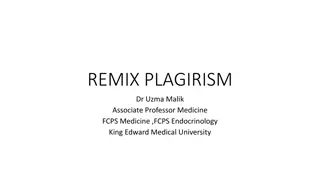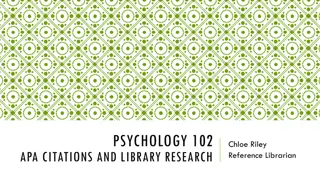Understanding and Avoiding Plagiarism: Essential Tips for Students
Plagiarism is presenting others' work as your own, which is considered academic theft. It's crucial to understand the concept, origins, and impact of plagiarism. Reasons students plagiarize include unawareness, poor time management, and lack of integration skills. Learn about intentional and unintentional plagiarism types, reasons, and how to prevent it to maintain academic integrity.
Uploaded on Nov 26, 2024 | 0 Views
Download Presentation

Please find below an Image/Link to download the presentation.
The content on the website is provided AS IS for your information and personal use only. It may not be sold, licensed, or shared on other websites without obtaining consent from the author. Download presentation by click this link. If you encounter any issues during the download, it is possible that the publisher has removed the file from their server.
E N D
Presentation Transcript
Plagiarism: What it Means and How to Avoid It
What Is Plagiarism? Plagiarism is the act of presenting the words, ideas, images, sounds, or the creative expression of others as your own.
What's the origin of the word plagiarism? The word plagiarism is derived from the Latin word plagiare, which means to kidnap or abduct
Why is it important to understand Plagiarism? Plagiarism is stealing of intellectual property Plagiarism is cheating Plagiarism is an Academic offence Plagiarism is Academic theft!
Why do students plagiarize? Excuses! Everyone does it! It s okay if I don t get caught! I was too busy to write that paper! This assignment was BORING! (Job, big game, too much homework!) I ve got to get into ??? U.! My teachers expect too much! My parents expect A s! Taken from Plagiarism PowerPoint at boe.qacps.k12.md.us/qhs/teachers/Boones/plagiarism.ppt
More Critical Reasons Why Students Plagiarize are : 1. Unaware of what constitute plagiarism 2. Do not understand why sources are so important and why all the fuss is about 3. Do not know how to integrate/incorporate source materials into their own arguments or assignment 4. Have poor time-management skills, running out of time. Hence, they have no choice but to plagiarise.
Two Types of Plagiarism Intentional Plagiarism *Copying a friend s work * Borrowing or buying assignments * Cut and paste from electronic resources * Downloading essays from the Internet and presenting as your own work Unintentional Plagiarism * Not knowing how to acknowledge or incorporate sources of information through proper paraphrasing, summarising and quotation *Careless copying, cutting and pasting from electronic databases *Quoting excessively * Failure to use your own voice
Be Aware of What Constitutes Plagiarism and Take Precaution Both intentional or unintentional plagiarism are not acceptable and are academic offences It is IMPORTANT that you acknowledge or give credit where it is due
Be Aware of What Constitutes Plagiarism and Take Precaution It does not matter whether the person whose work you have cited is alive or dead. You still have to cite if it is not your own idea If you paraphrase or translate some sections of a piece of work, you must give a citation If you take an image from the Internet or any source, you must cite the source
UTAR Policy: Penalty on Plagiarism The submission of a project report which is plagiarized will be rejected and referred to the Academic Disciplinary Committee for further action.
Do I have to cite everything? Taken from Plagiarism PowerPoint at boe.qacps.k12.md.us/qhs/teachers/Boones/plagiarism.ppt
Nope! Facts that are widely known, or Information or judgments considered common knowledge Do NOT have to be cited Hooray for common knowledge! -- taken from Joyce Brannon s Plagiarism. PowerPoint Presentation & Joyce Valenza s What is Plagiarism? (See works cited). (Internet downloads) boe.qacps.k12.md.us/qhs/teachers/Boones/plagiarism.ppt
Examples of Common Knowledge or Widely Accepted Facts The Nile is the longest river in the world The world is round The sun rises in the east If you see the information in three or more sources, and you are quite sure that your readers already know this information, it is likely to be common knowledge. However, whenever you are in doubt, cite!
You do not need to document/cite when: Writing your own experiences and observations Presenting the results of original research or experiments Writing your own thoughts, comments or conclusions in an assignment Evaluating or offering your own analysis Using common knowledge or folklore Using generally accepted facts or information
Whats the big deal? -- taken from Joyce Brannon s Plagiarism. PowerPoint Presentation & Joyce Valenza s What is Plagiarism? (See works cited). (Internet downloads) boe.qacps.k12.md.us/qhs/teachers/Boones/plagiarism.ppt
You can borrow from the works of others to be used in your own work! BUT HOW?
Use these 3 Strategies 1. Quotation 2. Paraphrasing 3. Summarizing This is to help you blend/incorporate source materials into your own writing and make sure that your voice is heard
Quotations Use quotations to support your arguments and add credibility to your research paper.
Tips for Using Quotations Students frequently overuse direct quotation Only about 10% of your final manuscript should appear as directly quoted matter
Example Interpreting these results, Robbins et al. (2003) suggested that the therapists in dropout cases may have inadvertently validated parental negatively about the adolescent without adequately responding to the adolescent s needs or concerns (p. 541), contributing to an overall climate of negativity.
For Quotations 1. Must be identical to the original. Match the source document word for word 2. Put quotation marks around the original author s exact words 3. Must reference the original source 4. Include the page number of the original source
Paraphrasing Presenting someone else s essential ideas and information in your own words or language
Example Original source: Lizzie Borden: A Case Book of Family and Crime in the 1890s by Joyce Williams, et al.: The rise of industry, the growth of cities, and the expansion of the population were the three great developments of late nineteenth century American history. As new, larger, steam-powered factories became a feature of the American landscape in the East, they transformed farm hands into industrial laborers, and provided jobs for a rising tide of immigrants. With industry came urbanization the growth of large cities (like Fall River, Massachusetts, where the Bordens lived) which became the centers of production as well as of commerce and trade.
After Paraphrasing Fall River, where the Borden family lived, was typical of northeastern industrial cities of the nineteenth century. Steam-powered production had shifted labor manufacturing, and as immigrants arrived in the US, they found work in these new factories. As a result, populations grew, and large urban areas arose. Fall River was one of these manufacturing and commercial centers (Williams, 1890). from agriculture to
For Paraphrasing 1. The paraphrased material is usually shorter than the original passage 2. Must use your own words 3. Must reference the original source
4 Steps to Paraphrasing 1. Select the information you need 2. Use your own words a. Use synonyms (words with same meaning) b. Interchange active and passive voice 3. Give credit to original author a. Use In-text Citation ( author-date style) 4. Compare what you wrote with the original text. a. Are main ideas and substance covered b. Di you use your own words and modify sentence structure c. Did you give credit to author of original source
Example of How to Select Information Aim: How has European settlement in Australia affected different Australian birds? Not all species have suffered from land clearing. A few bird species, such as the magpie, together with larger kangaroos such as the Eastern Grey and Red, have expanded their range as clearing creates more of their favoured grassland and open woodland habitats, while some butterflies have also expanded their range as far as Alice Springs, following the trees and flowers planted around homesteads across the outback. Not all species have suffered from land clearing. A few bird species, such as the magpie, together with larger kangaroos such as the Eastern Grey and Red, have expanded their range as clearing creates more of their favoured grassland and open woodland habitats, while some butterflies have also expanded their range as far as Alice Springs, following the trees and flowers planted around homesteads across the outback.
Summarizing The author s original words are rewritten into a substantially shortened form that captures the most important elements
Example Original source: "For the semantic web to function, computers must have access to structured collections of information and sets of inference rules that they can use to conduct automated reasoning. Artificial-intelligence researchers have studied such systems since long before the Web was developed. Knowledge representation, as this technology is often called, is currently in a state comparable to that of hypertext before the advent of the Web: it is clearly a good idea, and some very nice demonstrations exist, but it has not yet changed the world. It contains the seeds of important applications, but to realize its full potential it must be linked into a single global system."
After Summarizing Berners-Lee et al (2001) argue that incorporating artificial intelligence mechanisms of the Internet will result in new systems with potential to make a large impact on society. techniques into the References Berners-Lee, T., Hendler, J. & Lassila, O. (2001, May). The semantic web. Scientific American, 35-43.
For Summarizing 1. The text is much shorter than the original text 2. Must use your own words, usually with very limited use of quotations 3. Must reference the original source
In-Text Citations Whenever you paraphrase, summarise or quote from a particular source, you have to do In-text Citation An In-text Citation is referencing a work in the body of the text. It consist of the author s surname and date of publication. To include page number if there is a direct quotation For example: A study conducted by Bright and Western (1984) suggested a significant relationship between... Alternatively, when emphasizing a particular author's ideas, author name/s can become the subject of the sentence with the date only following in brackets. For example: Bright and Western (1984) have argued that...
Citation Styles UTAR is adopting the following citation styles: 1. APA Style (American Psychological Association) 2. Harvard Style
Which Style Should I Use? APA style for: Faculty of Accountancy & Management Faculty of Creative Industries Institute of Chinese Faculty of Arts and Social Science Faculty of Business & Finance
Which Style Should I Use? Harvard style for: Faculty of Engineering & Science Faculty of Science Faculty of Engineering & Green Technology Faculty of Information & Communication Technology
What Is Turnitin? Turnitin is an Internet-based plagiarism- prevention service that checks the documents for content that is not original. The results can be used to: identify similarities to existing sources to help students learn how to avoid plagiarism and improve their writing
What Is Turnitin? More than 3,500 higher education institutions use Turnitin, including 69 percent of the top 100 colleges and universities in the U.S. News and World Report Best Colleges list. UTAR subscribes to Turnitin since September 2012
How Turnitin Works? See the Original Work Turnitin preserves the original format of the paper allowing lecturers to view the student's original text, formatting, imagery and layout.
How Turnitin Works? Understand What is Original and What Isn't Turnitin shows how much of the student's paper matches content from our databases so instructors can quickly understand how much of the paper is unoriginal.
How Turnitin Works? View Student's Sources Matched sources from the paper appear in an easy- to-understand format revealing color-coded sources corresponding to non-original work.
How Turnitin Works? Access Vast Databases Turnitin contains 24+ billion web pages, 250+ million student papers and millions of articles.
How Turnitin Works? View One Comprehensive Report Lecturers can easily move between or overlay OriginalityCheck, GradeMark and PeerMark reports to gain a full understanding of the written work.
How Turnitin Works? For more information, you may visit turnitin.com
45 UTAR Library























